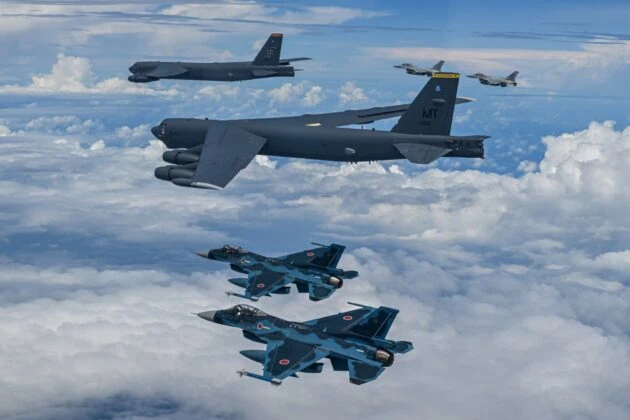
The United States, South Korea, and Japan conducted a joint air exercise over international waters south of Jeju Island on Thursday, featuring the deployment of a U.S. B-52H strategic bomber for the first time this year.
The exercise brought together the U.S. Air Force’s long-range bomber with South Korea’s KF-16 fighter jets and Japan’s F-2 fighters in a coordinated demonstration of allied deterrence and response capabilities.
According to the ministry, the drill aimed to strengthen trilateral cooperation against what it called North Korea’s “advancing nuclear and missile threats.”
“This exercise was conducted to enhance the deterrence and response capabilities of South Korea, the U.S., and Japan against North Korea’s escalating nuclear and missile threats,” the South Korean defense ministry said in a statement.
The mission coincided with the 22nd trilateral meeting of the three countries’ top military leaders in Seoul, where South Korean Joint Chiefs of Staff Chairman Gen. Kim Myung-soo, U.S. Joint Chiefs Chairman Gen. Dan Cane, and Japanese Chief of Staff Gen. Yoshihide Yoshida met to discuss regional security issues.
It was the first deployment of a U.S. B-52H to the Korean Peninsula this year. The strategic bomber, capable of delivering both conventional and nuclear weapons, underscores Washington’s commitment to the defense of its allies amid heightened tensions with Pyongyang.
Last month, South Korea, the U.S., and Japan held a similar air drill involving South Korean F-15K fighters, U.S. F-16s, and Japanese F-2s. However, the B-52H bomber was not included in that exercise.
Thursday’s operation marked the second trilateral air drill since the inauguration of President Lee Jae-myung’s administration in South Korea on June 4.
“The three countries will continue close coordination to sustain trilateral exercises, deter North Korean threats, and respond jointly,” the ministry said.